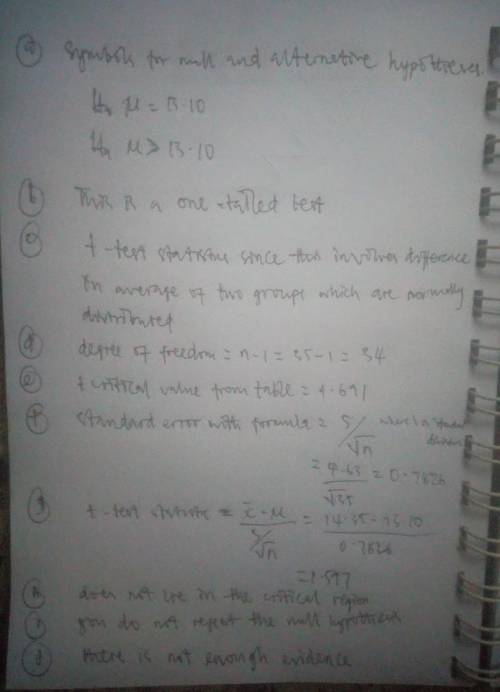
Mathematics, 20.09.2020 18:01 friezaforceelite
Suppose you have a sample of 35 children with antisocial tendencies and you are particularly interested in the emotion of surprise. You find that while the average 10 year old has a score of 13.10 on the emotion recognition scale, your sample of 10 year old children with antisocial tendencies has an average score of 14.35 with a standard deviation of 4.63. A higher score represents that it took a higher degree of emotional expression for the child to correctly identify the emotion of surprise, indicating greater difficulty recognizing the emotion. Assume that scores on the emotion recognition scale are normally distributed.
The null hypothesis is that your sample of children with antisocial tendencies would have no more difficulty recognizing emotion than the general population of 10-year olds. Stated using symbols:
(a). this is a
(b) tailed test. Given what you know, you will evalute this hypothesis using a
(c) statistic. In order to use the t distribution, you will first need to determine the degrees of freedom
(df) for alpha=.05. The degrees of freedom is:
(d). The critical value of t is:
(e) Calculate the t statistics. To do this, you will first have to calculate the estimated standard error. The estimated standard error is
(f). The t statistic is
(g). (Hint: for the most precise results, retain four significant figures from your calculation of the standard error to calculate the t statistic.)
The t statistic
(h) lie in the critical region. Therefore, you
(i) reject the null hypothesis.
Based on the results of this test, there
(j) enough evidence to conclude that children with antisocial tendencies have greater difficulty recognizing surprise than do children without antisocial tendencies:
Options for b: two- or one-
Options for c: z or t
Options for d: 33, 34, 35, 36
Options for e: .549, 2.032, 1.691, 1.645
Options for f: 0.38, 4.63, 0.78, 35
Options for g: 2.45, 1.60, 3.19, 3.30
Options for h: does not OR does
Options for i: cannot OR can
Options for j: is OR is not

Answers: 3


Another question on Mathematics

Mathematics, 21.06.2019 13:00
Which of the following system of equation is not equal to the system of equations is not equal to the system of equations shown below
Answers: 3

Mathematics, 21.06.2019 14:00
9. (y^-5)^10y^10 a. y^-60 b. y^60 c. y^-150 d. y^150 find the simplified form of each expression. 10. (4/7^5)^2 a.8/14^10 b.16/49^25 c.16/49y^10 d.8/14y^25 11. determine if the number 3.43 times 10^-6 is written in scientific notation. if not, explain. a. yes; the number is written scientific notation. b. no; the first factor is not a number between 1 and 10. c. no; it is not written as a number times a power of 10
Answers: 3

Mathematics, 21.06.2019 18:10
Which points are solutions to the linear inequality y < 0.5x + 2? check all that apply. (–3, –2) (–2, 1) (–1, –2) (–1, 2) (1, –2) (1, 2)
Answers: 3

Mathematics, 22.06.2019 01:20
Can you me with this question? i'll reward *30 points i just need with this one question so that i could solve the others. * edit: i originally set up the question to reward 30 points, but for some reason i can only reward 15. if you don't get 30, then i'm sorry. i'm still kind of new to this site
Answers: 1
You know the right answer?
Suppose you have a sample of 35 children with antisocial tendencies and you are particularly interes...
Questions



History, 14.12.2020 18:00

Mathematics, 14.12.2020 18:00

Mathematics, 14.12.2020 18:00

Biology, 14.12.2020 18:00

Mathematics, 14.12.2020 18:00


History, 14.12.2020 18:00

Mathematics, 14.12.2020 18:00

Mathematics, 14.12.2020 18:00

Chemistry, 14.12.2020 18:00


Mathematics, 14.12.2020 18:00

Arts, 14.12.2020 18:00


Business, 14.12.2020 18:00



Mathematics, 14.12.2020 18:00




